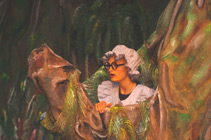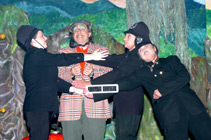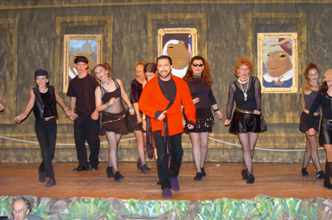 Kenneth
Grahame's novel, The Wind in the Willows, tells the story of animals, and
animals about which stories are not often told -- rats, moles, toads, weasels
and stoats to name the most obvious. The enduring quality of the book is
due to Grahame's making nature accessible and sympathetic by giving these
animals very human qualities, and that has been maintained in this musical
adaptation. The characters should not be portrayed realistically in furry
costumes with masks or heavy make-up, but rather in clothes that illuminate
their personalities and with make-up that simply suggests their animalness.
Kenneth
Grahame's novel, The Wind in the Willows, tells the story of animals, and
animals about which stories are not often told -- rats, moles, toads, weasels
and stoats to name the most obvious. The enduring quality of the book is
due to Grahame's making nature accessible and sympathetic by giving these
animals very human qualities, and that has been maintained in this musical
adaptation. The characters should not be portrayed realistically in furry
costumes with masks or heavy make-up, but rather in clothes that illuminate
their personalities and with make-up that simply suggests their animalness.Rat is a quiet country gentleman, happy with his boat and fond of nature; he's comfortable with his place in it and asks no more of life. Toad is flamboyant, rich and self -centered; flying from one fad to another, his true hobby is material possessions. Mole has lived as an introvert, disinterested in clothes or the physical world. In fact, her world has been lived in her imagination until she finally emerges, meets Rat, and transforms into a funny, caring female who gets prettier as the story progresses.
 As
in the original Washington, D.C. run of the show at the Folger Theatre,
the Rabbit chorus can be used to move props and provide scene changes as
well as colorful touches of humor. The Weasels and Stoats (male and female,
respectively) are the equivalent of urban punks and are drawn with humor
as well as menace. Their costumes should be skin tight, inspired by the
litheness of the actual animals, with touches of leather and fake fur. The
Chief Weasel sports a rabbit's foot from his belt and wears sunglasses for
his opening scene. There are humans in the musical who appear as representatives
of the Wide World beyond the Wild Wood. In both the Washington and Broadway
productions, the furniture in the courtroom scene was built of a size to
diminish Toad. The Policemen, the Judge and Members of the Court were dressed
in the classic English style -- white wigs and black gowns.
As
in the original Washington, D.C. run of the show at the Folger Theatre,
the Rabbit chorus can be used to move props and provide scene changes as
well as colorful touches of humor. The Weasels and Stoats (male and female,
respectively) are the equivalent of urban punks and are drawn with humor
as well as menace. Their costumes should be skin tight, inspired by the
litheness of the actual animals, with touches of leather and fake fur. The
Chief Weasel sports a rabbit's foot from his belt and wears sunglasses for
his opening scene. There are humans in the musical who appear as representatives
of the Wide World beyond the Wild Wood. In both the Washington and Broadway
productions, the furniture in the courtroom scene was built of a size to
diminish Toad. The Policemen, the Judge and Members of the Court were dressed
in the classic English style -- white wigs and black gowns.The most successful set of these two productions was a unit set. The stage reached out into the theatre itself with branches of trees surrounding the audience. The set represented a glade in the woods that became variously Rat's meadow with an imaginary river on which a row boat was pulled along by wires from offstage; the lawn at Toad Hall with a picture of the mansion hanging from a backdrop; the inside of Toad Hall with a few portraits of Toad's ancestors, a suit of armor and a large dining table; the Wild Wood with a few more bushes and a large rock. The rock turned to create the interior of Badger's cozy underground home. It had the remains of a Roman wall painted on it, some china and a few socks hung up to dry. This cozy nook in the middle of the Wild Wood works particularly well at the end of Act I when the carol is sung. With the rock turned to form a shelter for Badger, Mole and the Rabbits -- soft, warm lights shining on their faces and red woollen scarves around their necks -- the cold world outside is a particularly striking contrast, the Weasels and Stoats huddled outside Badger's door in the Wild Wood, trying to share some of the joy of the carol being sung inside Badger's home. Snowflakes fluttering down enhance their sense of isolation and increase their motivation for capturing Toad Hall.
The two biggest props -- Toad's gypsy wagon and the Frenchman's car -- can be as complicated or as simple as desired. The car can be either a tour de force for mechanical wizards or a testimony to the power of imagination with four open umbrellas twirled by the Rabbits around a chair. A strobe light is used in the Gasoline Can-Can number to give the impression of fantasy and speed.
 Other
production ideas that might be helpful: a map showing the location of the
river, the homes of the characters who live along it, and the location of
the Wild Wood and the Wide World could be used as a show curtain or backdrop,
as was done in a very successful production in Springfield, Missouri. To
change the atmosphere of the set for the Wild Wood in Scene 6, one could
move on pieces covered with Spanish moss or other sinister-looking leaves;
behind them, shrouded black figures could twirl wires attached to flying
insects or bats. In Toad's escape from jail, when he is being chased by
the Police, it's good fun to have two other actors also dressed as Toad,
so that as the chase moves out through the audience, Toad appears to be
almost everywhere.
Other
production ideas that might be helpful: a map showing the location of the
river, the homes of the characters who live along it, and the location of
the Wild Wood and the Wide World could be used as a show curtain or backdrop,
as was done in a very successful production in Springfield, Missouri. To
change the atmosphere of the set for the Wild Wood in Scene 6, one could
move on pieces covered with Spanish moss or other sinister-looking leaves;
behind them, shrouded black figures could twirl wires attached to flying
insects or bats. In Toad's escape from jail, when he is being chased by
the Police, it's good fun to have two other actors also dressed as Toad,
so that as the chase moves out through the audience, Toad appears to be
almost everywhere.No attempt has been made to make this adaptation a period piece. The show blends old and new, American and English with ease. After all, it is set in a world of fantasy. But above all, this is a show to have fun with. The Rabbit chorus can contain as many adults and children as desired, the fight scene can be as serious or as humorous as you wish. The Weasels and Stoats, while not being thoroughly unlikable, can be as outlandish as seems appropriate. It's a show about friendship, and that's what draws four unlikely animals like Mole, Rat, Toad and Badger together and keeps them together through any and every adversity.
Jane Iredale
 |
 |
 |
|
|
Lamoille County Players, Hyde Park, VT |
|
Concord Theatricals